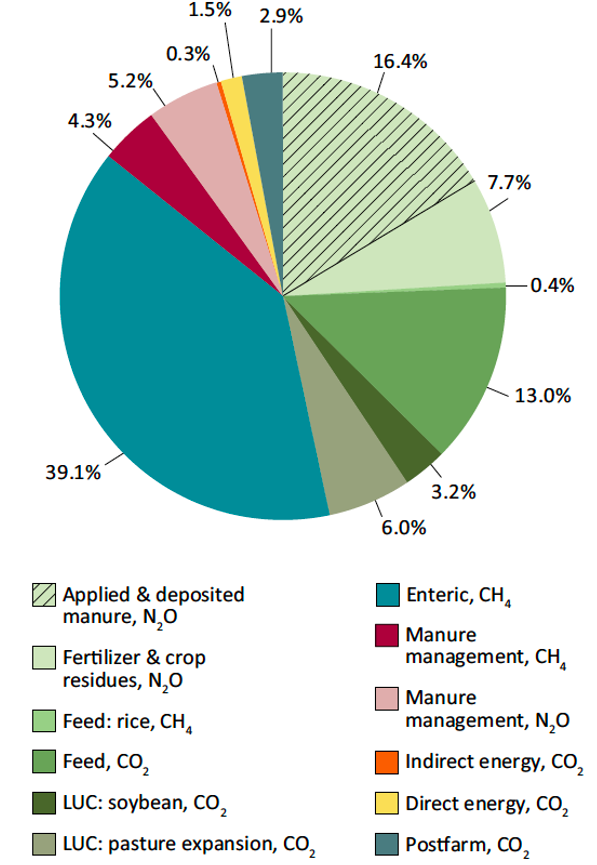What is livestock production?
Livestock production systems produce meat, milk, animal products, or services and provide essential protein sources. Livestock production is the largest source of greenhouse gas (GHG) emissions in the agricultural sector. These emissions are expected to increase as the global population and demand increase.
Livestock production systems create emissions along the supply chain from animals, pasture or rangeland, agroforestry, feed production, manure management, energy use (e.g., refrigeration, transport), cement structures, and land-use change. Food loss or waste (FLW) can be an unnecessary source of additional emissions. Livestock includes cattle, sheep, goats, and other ruminants but does not include fisheries or insect production.
Livestock supply chains contributed 7.1 GtCO2e (1 Gt = 1,000,000,000 metric tons) in 2005, or 14.5% of human-induced GHG emissions. GHG emissions and their mitigation from livestock systems occur at the farm, landscape, and supply chain levels. Approximately 87.6% (6.2 GtCO2e) of livestock emissions are from the farm, 9.2% (0.65 GtCO2e) from land-use change, and 3.2% (0.22 GtCO2e) from the rest of the supply chain (Fig. 1).
Emissions by source

Emissions from the livestock supply chain originate from four principal sources (Fig. 1):
- Enteric fermentation from the digestive processes of ruminant livestock (such as cattle, goats and sheep) represents the greatest GHG source within livestock production systems. Enteric fermentation accounts for 4.4% of global emissions.
- Feed production relates to crops grown for livestock consumption. To keep up with the demand for increasing animal products and the subsequent demand in feed, rates of deforestation and conversion of native ecosystems are also on the rise (Land Use Change (LUC) in Fig. 1)
- Manure management relates to the storage and handling of animal excretes, which emit GHGs when broken down under anaerobic conditions.
- Energy consumption occurs during the manufacturing of farm inputs (e.g., fertilizers and pesticides), farm operations (e.g., planting and harvesting), transportation, processing, and food distribution for livestock consumption.
Better management of grazing lands could offset livestock sector emissions. Grazing management practices with the potential to increase soil C stocks include (i) stocking rate management, (ii) grazing exclusion, and (iii) prevention of overgrazing. A meta-analysis synthesizing 133 published studies observing the effects of grassland management on soil C sequestration rates across China demonstrated that grazing exclusion can sequester 130.4 g C m-2 year-1. It is important to note that soil C stock changes under improved grazing management are highly dependent on climate regime and grassland type.
Emissions by commodity and emission intensities
Emission intensities are measured using two main indicators: emissions per hectare and emissions per quantity of product. Emission intensities are a way to compare the performance of different commodities to express the emissions on a per-product basis (e.g., kg CO2e per kg of meat).
Global average emission intensities for livestock are highest for beef (nearly 300 kg CO2e per kg protein). Meat and milk production from small ruminants have the second-largest emission intensities (165 and 112 kg CO2e per kg product, respectively). However, at the sub-global level, emission intensities vary greatly among the same commodity type as a result of different livestock practices and inputs used around the world. For example, the emission intensity of buffalo meat production is relatively high in East and Southeast Asia due to low animal productivity as a result of poor feed resources and reproductive efficiency.
Mitigation strategies
1. At the animal level:
- Optimize feed digestibility and feed balancing.
- Achieve greater animal health through vaccination and sanitation.
- Improve animal breeding and genetics to increase food conversion ratios and reduce the amount of nitrogen excreted per unit of product.
2. At production unit level:
- Improve grazing and grassland management to increase feed quality and promote soil carbon sequestration.
- Improve the quality and utilization of crop residues and fodder.
- Enhance manure management (collection, storage, and processing). Anaerobic digesters are a promising infrastructure to recover biogas and other useful coproducts from manure.
- Optimize manure application rates and timing. Improved nutrient management strategies can reduce field-based N2O emissions.
- Produce or source low-emission-intensity feed.
- Avoid expansion into native ecosystems that result in conversion from high to low carbon stock lands (e.g., wetlands, forests, and mangroves to crop or pasture).
3. At the supply chain level:
- Adopt energy-efficient practices and equipment and renewable energy where possible.
- Minimize food loss through improved handling, transportation, and storage.
- Increase nutrient recovery and upcycling.
4. At the consumer level:
- Reduce the demand for animal products by opting for plant-based products.
- Purchase locally sourced animal products.
- Minimize food waste.
